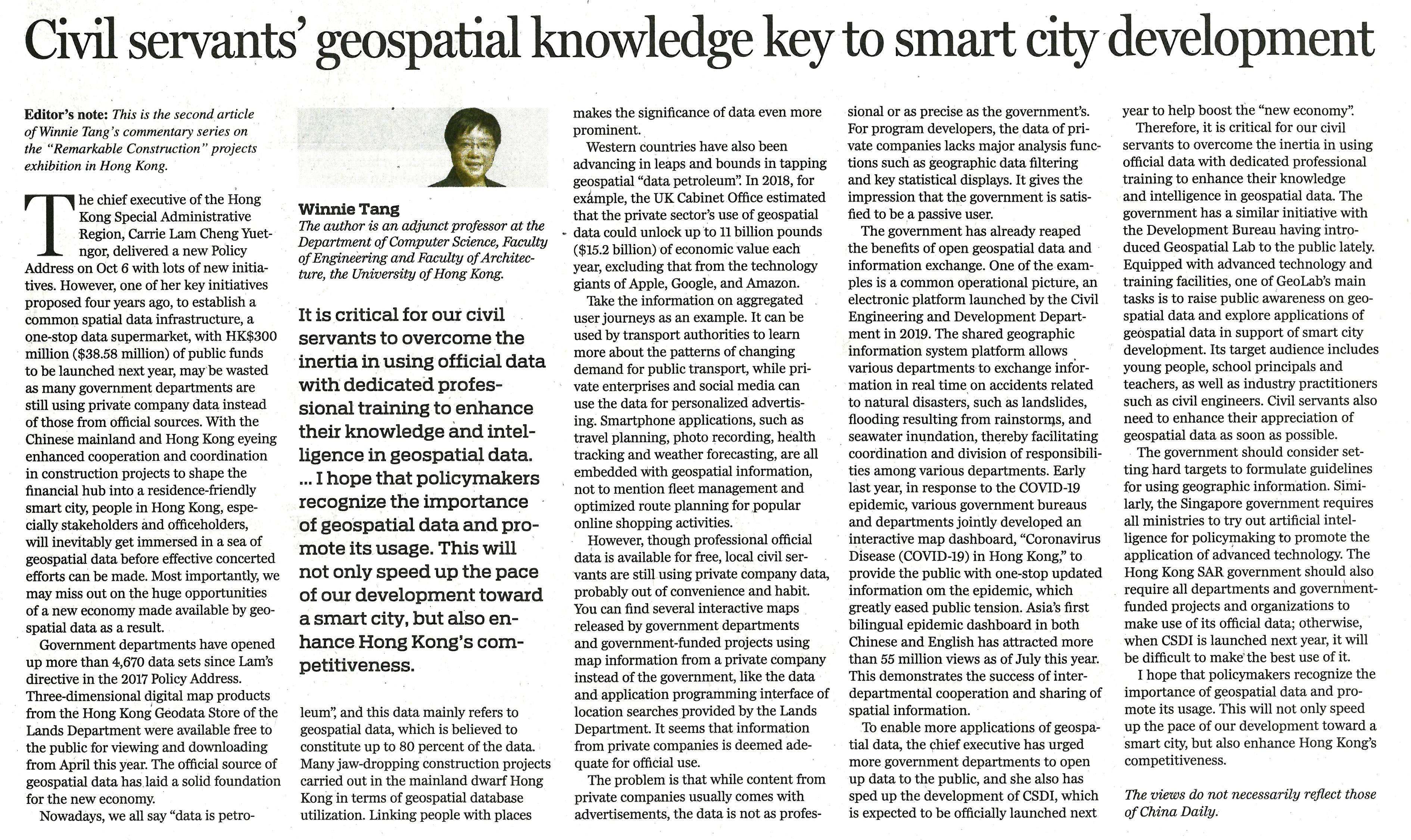網上版請按此

Civil servants' geospatial knowledge key to smart city development
The chief executive of the Hong Kong Special Administrative Region, Carrie Lam Cheng Yuet-ngor, delivered a new Policy Address on Oct 6 with lots of new initiatives. However, one of her key initiatives proposed four years ago, to establish a common spatial data infrastructure, a one-stop data supermarket, with HK$300 million ($38.58 million) of public funds to be launched next year, may be wasted as many government departments are still using private company data instead of those from official sources. With the Chinese mainland and Hong Kong eyeing enhanced cooperation and coordination in construction projects to shape the financial hub into a residence-friendly smart city, people in Hong Kong, especially stakeholders and officeholders, will inevitably get immersed in a sea of geospatial data before effective concerted efforts can be made. Most importantly, we may miss out on the huge opportunities of a new economy made available by geospatial data as a result.
Government departments have opened up more than 4,670 data sets since Lam's directive in the 2017 Policy Address. Three-dimensional digital map products from the Hong Kong Geodata Store of the Lands Department were available free to the public for viewing and downloading from April this year. The official source of geospatial data has laid a solid foundation for the new economy.
Nowadays, we all say "data is petroleum", and this data mainly refers to geospatial data, which is believed to constitute up to 80 percent of the data. Many jaw-dropping construction projects carried out in the mainland dwarf Hong Kong in terms of geospatial database utilization. Linking people with places makes the significance of data even more prominent.
Western countries have also been advancing in leaps and bounds in tapping geospatial "data petroleum". In 2018, for example, the UK Cabinet Office estimated that the private sector's use of geospatial data could unlock up to 11 billion pounds ($15.2 billion) of economic value each year, excluding that from the technology giants of Apple, Google, and Amazon.
Take the information on aggregated user journeys as an example. It can be used by transport authorities to learn more about the patterns of changing demand for public transport, while private enterprises and social media can use the data for personalized advertising. Smartphone applications, such as travel planning, photo recording, health tracking and weather forecasting, are all embedded with geospatial information, not to mention fleet management and optimized route planning for popular online shopping activities.
However, though professional official data is available for free, local civil servants are still using private company data, probably out of convenience and habit. You can find several interactive maps released by government departments and government-funded projects using map information from a private company instead of the government, like the data and application programming interface of location searches provided by the Lands Department. It seems that information from private companies is deemed adequate for official use.
The problem is that while content from private companies usually comes with advertisements, the data is not as professional or as precise as the government's. For program developers, the data of private companies lacks major analysis functions such as geographic data filtering and key statistical displays. It gives the impression that the government is satisfied to be a passive user.
The government has already reaped the benefits of open geospatial data and information exchange. One of the examples is a common operational picture, an electronic platform launched by the Civil Engineering and Development Department in 2019. The shared geographic information system platform allows various departments to exchange information in real time on accidents related to natural disasters, such as landslides, flooding resulting from rainstorms, and seawater inundation, thereby facilitating coordination and division of responsibilities among various departments. Early last year, in response to the COVID-19 epidemic, various government bureaus and departments jointly developed an interactive map dashboard, "Coronavirus Disease (COVID-19) in Hong Kong," to provide the public with one-stop updated information om the epidemic, which greatly eased public tension. Asia's first bilingual epidemic dashboard in both Chinese and English has attracted more than 55 million views as of July this year. This demonstrates the success of inter-departmental cooperation and sharing of spatial information.
To enable more applications of geospatial data, the chief executive has urged more government departments to open up data to the public, and she also has sped up the development of CSDI, which is expected to be officially launched next year to help boost the "new economy".
Therefore, it is critical for our civil servants to overcome the inertia in using official data with dedicated professional training to enhance their knowledge and intelligence in geospatial data. The government has a similar initiative with the Development Bureau having introduced Geospatial Lab to the public lately. Equipped with advanced technology and training facilities, one of GeoLab's main tasks is to raise public awareness on geospatial data and explore applications of geospatial data in support of smart city development. Its target audience includes young people, school principals and teachers, as well as industry practitioners such as civil engineers. Civil servants also need to enhance their appreciation of geospatial data as soon as possible.
The government should consider setting hard targets to formulate guidelines for using geographic information. Similarly, the Singapore government requires all ministries to try out artificial intelligence for policymaking to promote the application of advanced technology. The Hong Kong SAR government should also require all departments and government-funded projects and organizations to make use of its official data; otherwise, when CSDI is launched next year, it will be difficult to make the best use of it.
I hope that policymakers recognize the importance of geospatial data and promote its usage. This will not only speed up the pace of our development toward a smart city, but also enhance Hong Kong's competitiveness.
Dr. Winnie Tang
Adjunct Professor, Department of Computer Science, Faculty of Engineering; Department of Geography, Faculty of Social Sciences; and Faculty of Architecture, The University of Hong Kong